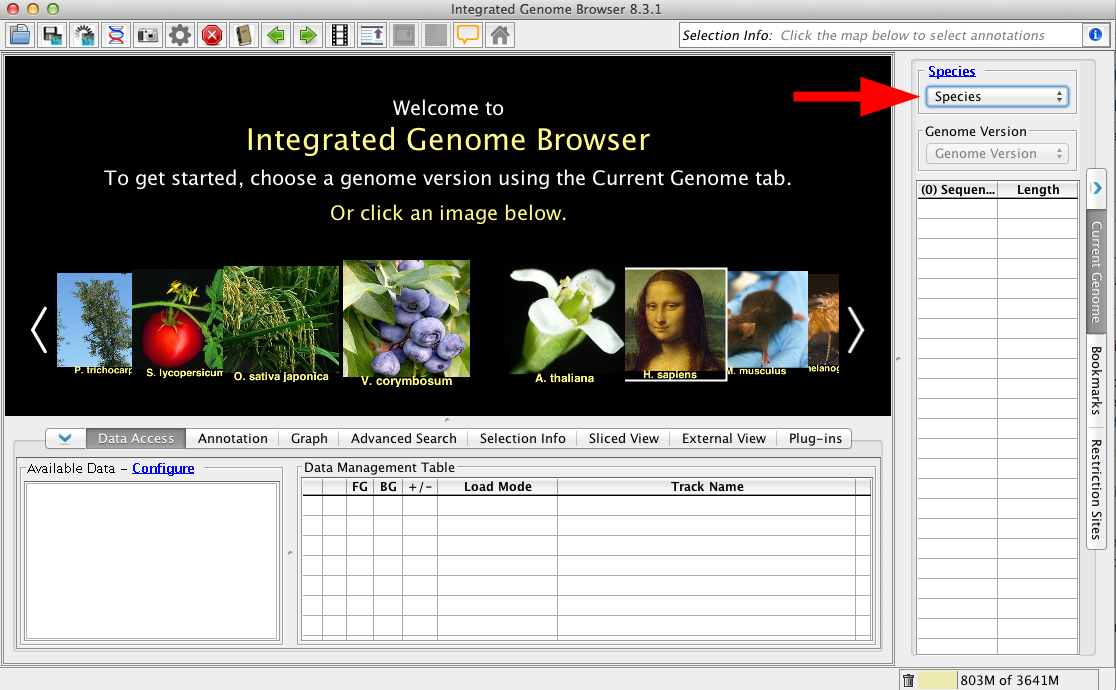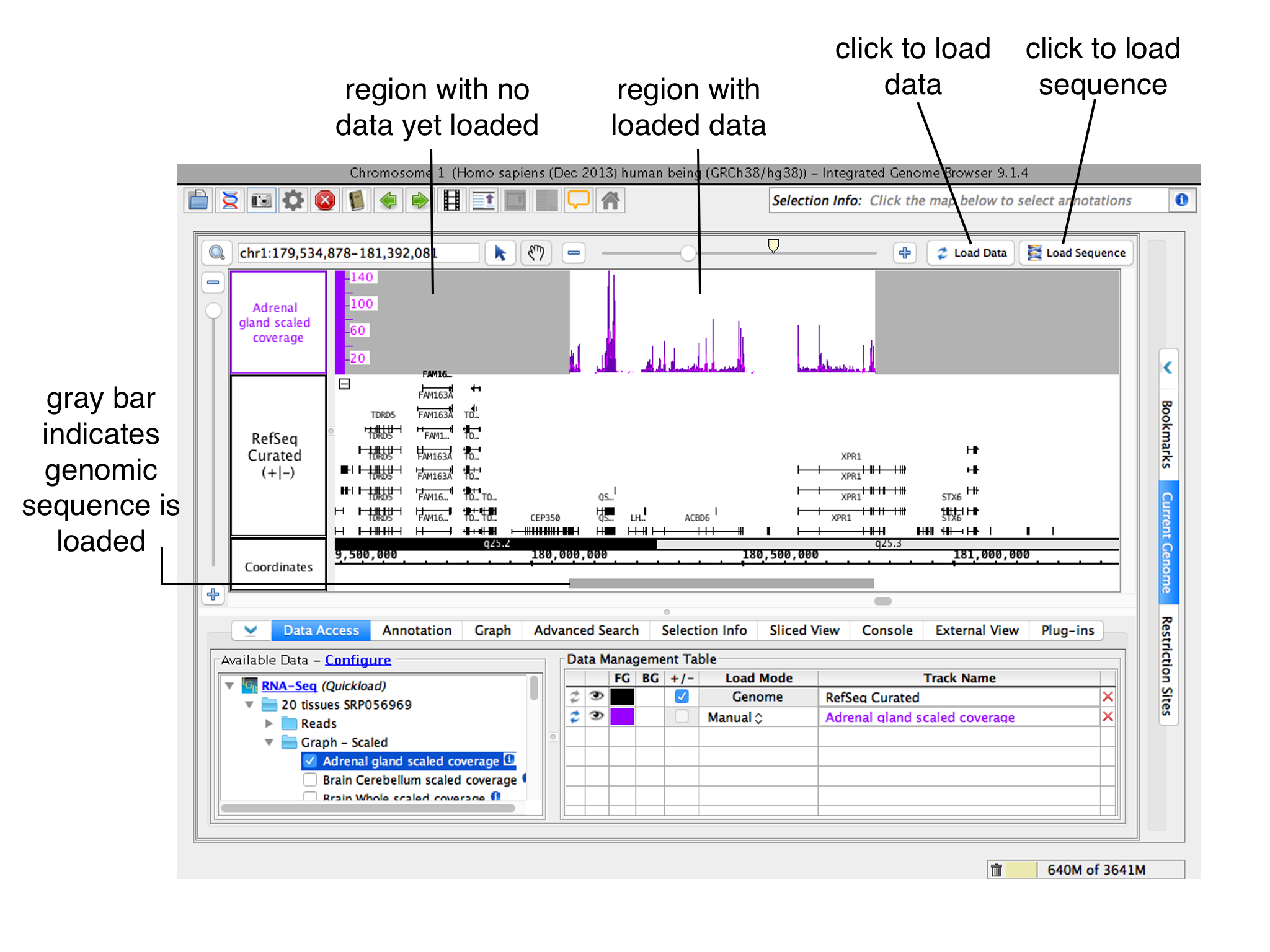| Table of Contents |
|---|
Introduction
IGB aims to be an integrated genome browser, meaning it can display data from a variety of diverse data sources, all merged into can integrate and merge data from multiple sources in the same view. This These includes data sets loaded from your computer, from URL sites, or from various public (and private) DAS, DAS2 and Quickload servers. IGB can also display data from many file types, including:
- Short read alignments data, aka "next generation sequence data" (BAM format)
- Standard annotations such as RefSeq annotations, provided by public repositories
- Alignments of Affymetrix probe sets to the genome, provided by the NetAffx group at Affymetrix (link.psl format).
- Alignments of ESTs or mRNAs produced by blat (psl formats)
- Tiling array graphs, from the TAS program from Affymetrix
- Copy number graphs from the CNAT program Affymetrix
- Data generated from other Affymetrix software tools, such as GCOS, Expression Console and ExACT.
- Annotation and graph files prepared by any method in any of the supported formats.
A list of supported file formats is here.
To load data:
| Table of Contents |
|---|
...
Choose Species and Genome Version
The first step to loading data is to choose Use the Current Genome tab to select a Species and Genome Version. IGB uses this information to offer data sources with relevant data sets. To set the species and version, select them in the Current Genome panel.Alternatively, if you chose to open a file from Or select an image on the Start Screen.
You can also open custom genomes not already available in IGB. See Custom Genomes (Genomes not in IGB).
...
Open data sets - from files, Quickload sites, URLs, or other sources
Once you select a species and genome version, publicly accessible data sets hosted on IGB Quickload sites or other sources will appear in the Available Data section of the Data Access tab. Select these data sets to open them in IGB.
You can also open files. To open a file, select File > Open File... or File > Open URL... the file selection widow will permit you to specify species and genome using the drop down menus at the bottom of the window.
While some file types contain information specifying their species and genome version, most do not. However, if you load a file that has the species and genome information, IGB will open the proper species and genome, even if it is not the one you have chosen.
Loading data sets
| Note |
|---|
IGB does NOT immediately display loaded files. Many of today's next-gen sequencing files are too big to display all at once. IGB handles this issue by waiting to visualize data sets until you ask it to load data. |
While you can immediately refresh to visualize most files, many larger file types, such as BAM and WIG should first have a defined, smaller region selected prior to refreshing the image.
There are several ways to get data sets into IGB, from servers/sources, from URLs and from the local computer. To load data from a server, locate the data set in the folders of the Data Sources panel. Put a check in the box next to the data you are interested in. This file will be entered into the Data Management Table.
For files loaded from URL or from the local computer, just drag and drop into the IGB interface; the file will immediately appear in the Data Management Table. Alternatively, use the File > Open File.. or Open URL... to find and load the file(s) you want. Be sure to set the species and genome at the bottom of the file selection window.
Data Management Table
IGB is capable of loading and displaying whole genomes, whole chromosomes or just portions of a data file, depending on the file type. Therefore, although there are many load options, not every file type can be loaded the same way. There is always the option of Don't Load, which will simply not load the individual file but will maintain it in the list.
...
.
Once a file is opened, IGB adds it to the Data Management Table in the Data Access tab.
| Note |
|---|
Opening a file does not automatically cause IGB to start showing data in the file. Because some data files are very large, you must first zoom in and click the Load Data button load the data into IGB. |
...
Use Data Management Table to configure data loading settings (optional)
To change how and when IGB loads data into a track, open the Data Access panel and change settings under Load Mode in the Data Management Table.
Options include:
- Don't Load means no data will load when you click the Load Data button.
- Genome triggers automatic loading of all data from a file.
- Manual means that only data overlapping for the currently displayed region will load when you click Load Data. This is the default setting.
- Auto means that moving or zooming to a new location triggers data loading, but only when the zoom threshold is lower than the mark shown on the horizpontal zoomer. Change the threshold by selecting View > Set AutoLoad Threshold to Current View. This will change the needed zoom level AND will move the yellow arrow to indicate the new threshold setting.
...
Load data to visualize
If the data is set to Load Mode > Manual, simply click Load Data. If you want all the tracks to load data at once, use the Load Data button (red box, arrow); to load a single track use the Load Data icon in the Data Management Table (red arrow). Sequence can be loaded from the Load Sequence button (purple box, arrow).
You might load a track and then zoom out to show a greater region of the data sets. IGB will show gray where the track is not loaded yet (red arrows).
...
Click Load Data or Load Sequence buttons
To load data for all visible tracks with load mode setting Manual, click the Load Data button.
To load reference sequence, click the Load Sequence button.
To load all data for a data set, change its Load Mode in the Data Management Table to Genome.
Regions where data have not yet been loaded have gray background color.




